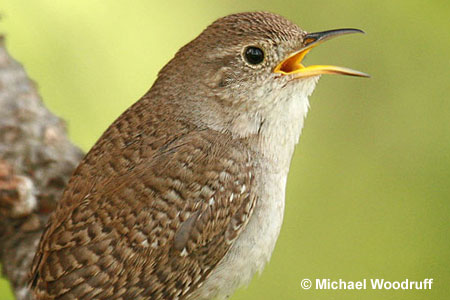House Wrens (Troglodytes aedon) are small but energetic with lovely bubbly chattering songs. These common backyard birds can be found throughout North and South America, and their distinct calls can be heard in backyards, parks, and forests alike.
Despite their diminutive size, house wrens are fiercely territorial and will defend their nesting sites with impressive gusto.
On this page
Adult
Although the female and male House Wren look the same, you’re likely to meet birds from this species that differ in the specific shade of their plumage, the amount of barring, wing and tail proportions, and vocalizations. This is because House Wrens have around 30 subspecies.
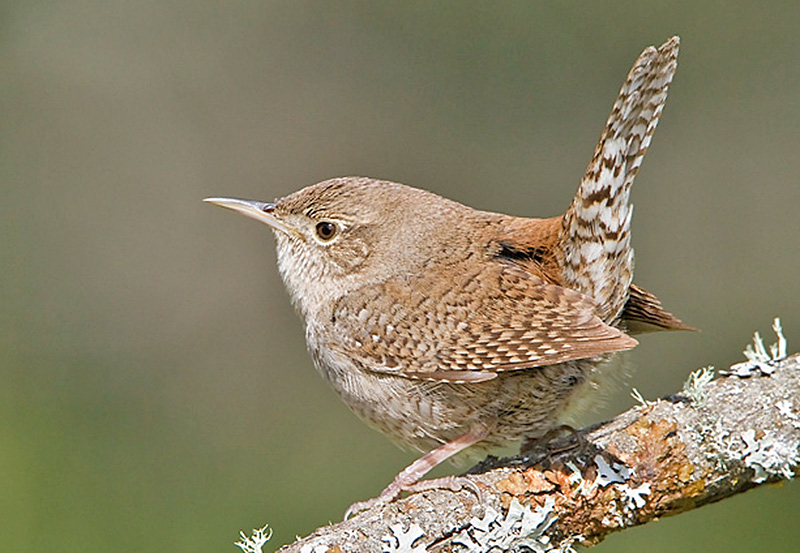
Photograph © Glenn Bartley.
Overall, these small and compact birds keep their tail slightly cocked and remain rather unnoticed, thanks to their nondescript brown plumage. They are colored in browns, grays, and pale tones, which vary depending on location.
Their upper side is usually darker and the underside lighter. The birds can have fine barring on their heads, back, wings, flanks, and underside, but the specifics differ from subspecies to subspecies.
House Wrens are rather small, measuring 4.3-5.1 inches long and weighing around 0.3-0.4 ounces.
Juvenile
House Wren eggs are small white, pink-white, or grayish in color and speckled with brown. The female lays 3-10, mostly 6-7 eggs in a clutch and incubates them for around 15-17 days. They leave the nest in about 15-17 days and reach independence after another two weeks.
Juvenile House Wrens look quite similar to adults, but their plumage has a reddish tinge to it. They also look a bit ruffled and uncertain.
Habitat
House Wren’s habitats change slightly depending on the time of the year. In summer, they prefer semi-open areas with scattered trees and grass, such as open woodlands, orchards, streamside groves, woodlots, yards, and other similar places.
During the winter, they move to habitats that offer more cover, such as places with dense low growth, thickets, riparian forests, and brushes.
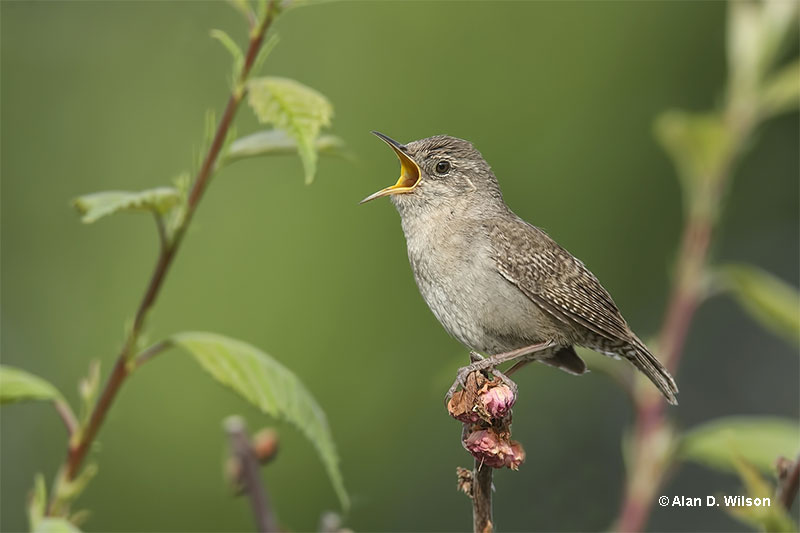
© Alan D. Wilson
House Wrens nest closer to the ground in both natural and artificial cavities, including woodpecker holes, nest boxes, holes in trees and tree stumps, and crevices in buildings.
The male House Wren constructs the nest foundation from twigs, and the female finishes the cup by topping it off with softer plant fibers, such as grasses and weeds, and lines it with animal hair or feathers.
Diet
House Wrens are carnivorous and mostly feed on insects. This includes beetles, grasshoppers, caterpillars, bugs, crickets, moths, spiders, millipedes, snails, earwigs, and leafhoppers. They also add calcium to their diet by ingesting mollusk shells, such as snail shells.
House Wrens forage during the day. They may hunt on the ground, in shrubs, high in trees amongst foliage, and also on tree trunks.
Most of the time, they will hunt on the ground or on lower branches and shrubs.
Behavior
House Wrens are rather solitary and territorial. They are either alone, in pairs, or in small groups. These birds are monogamous, but they change partners almost every season. Males defend and mark their territory by singing, putting on a display, and chasing and attacking. Females defend the nest.
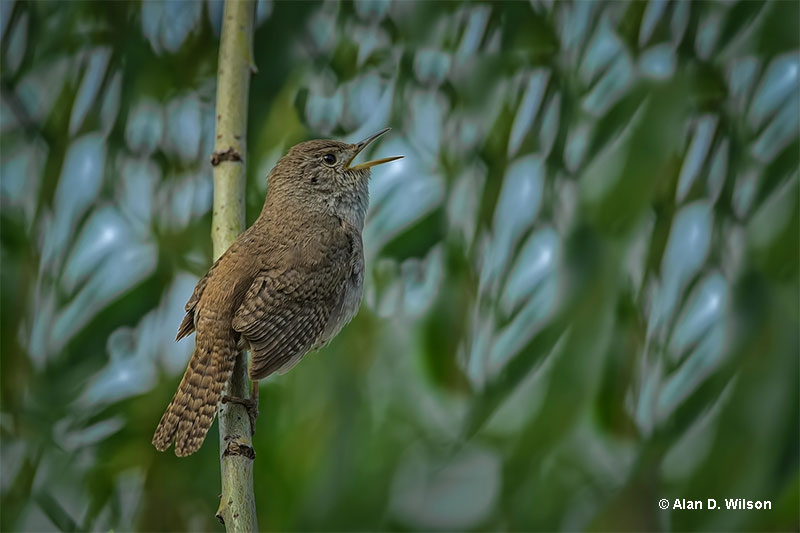
© Alan D. Wilson
The aggressiveness is especially noticeable during the breeding season. Single males will still try to win the female’s approval even after she has begun nesting. If the new male succeeds, the old nest and any existing nestlings or eggs will be abandoned.
Range (and seasonal changes)
House Wrens range throughout most of the Americas. They are year-round residents in South America, the southern half of Central America, and in some parts of northern Central America.
Their breeding range extends throughout most of the United States and a part of southern Canada. They are short-distance migrants and migrate to Mexico and the southern United States for winter.
House Wrens are listed as of least concern on the IUCN Red List. They are very successful and adaptable, being tolerant of habitat alteration, pesticides, and disturbances, and can live side-by-side with humans.
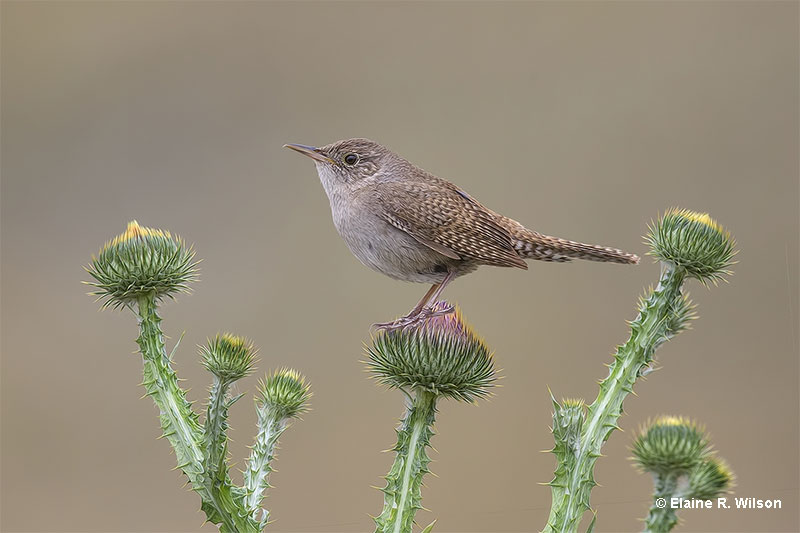
© Elaine R. Wilson
Wing shape
House Wren’s wingspan is 5.9 inches, which is just slightly longer than its length. Their wings are short and round, which enables them to adeptly maneuver through thickets, shrubs, and other areas with dense vegetation.
Fun Facts
- House Wrens add spider egg sacs into their nests. Once the spiders hatch, they will feed on mites and other parasites that might harm wren nestlings.
- House Wrens are rather aggressive and will also compete with larger bird species for suitable nesting sites. They might drag eggs and nestlings out of the nest and even kill adult birds.
- House Wrens are adept nest builders. The female may bring 4-5 sticks into the nest in the course of only one minute!
- House Wrens symbolize rebirth, determination, enthusiasm, and happiness.
Call
House Wren’s song is a vibrant and energetic chattering made up of many churrs and chatters. Both sexes sing, although females sing to answer their mates and include high-pitched squeals. Mated males sing a whispering song that is only sung during copulation. House Wrens call with different rattles, churrs, chatters, and scolds. They may also snap their beaks.
Similar Species
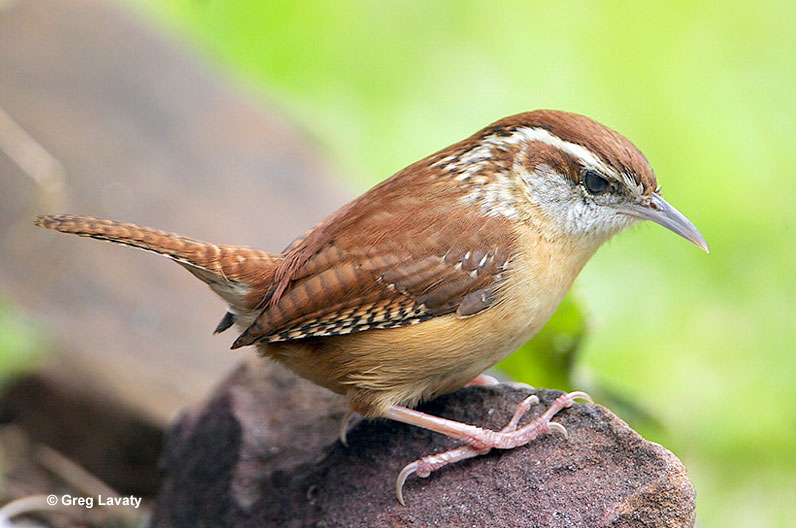
Carolina Wren
Although they look similar at first sight, Carolina Wrens are much lighter in color, their plumage is rusty brown, but some softer hues. Carolina Wrens have some markings on their faces.
They are similar in size, but Carolina Wrens can be a bit bigger.
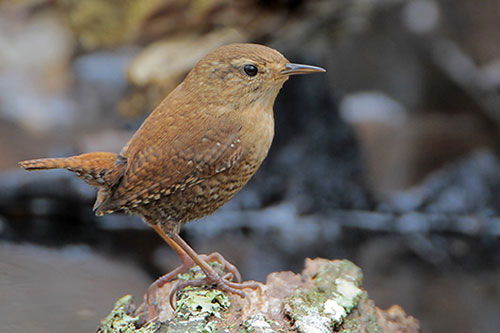
Winter Wren
A bit smaller in size, Winter Wrens are not as commonly seen as House Wrens.
Winter Wrens tend to be a touch darker in color compared to House Wrens, but they have similar barred pattern.
Winter Wrens have shorter tails and often look poofy.
Frequently Asked Questions
Why are they called House Wrens?
House Wrens got their name from the fact that they tend to nest near human settlements, specifically suburbs and rural settlements. It is a common backyard bird.
Are House Wrens friendly?
House Wrens are friendly with humans but may be rather aggressive with other birds.
Are wrens good to have around?
House Wrens are good to have around if you like bubbly and vibrant chattering songs. They will also hunt pest insects.

